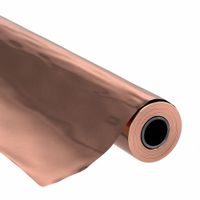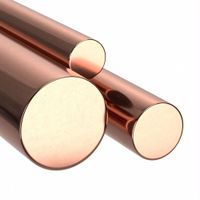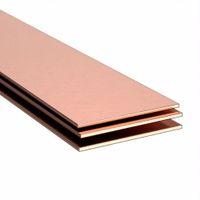Call +(254) 703 030 000 / 751 483 999 / 721 704 777
- Home
- Raw Materials
- Metals
- Copper
.....Read More
Frequently Asked Questions
What are the common uses of copper sheets and plates?
Copper sheets and plates are versatile materials used across various industries due to their excellent thermal and electrical conductivity, corrosion resistance, and malleability. Here are some common uses:
1. **Electrical Applications**: Copper's superior conductivity makes it ideal for electrical components. It is used in the manufacturing of circuit boards, electrical switches, and connectors. Copper sheets are also used in the production of transformers and other electrical equipment.
2. **Construction and Architecture**: Copper sheets are popular in roofing, cladding, and flashing due to their durability and aesthetic appeal. They develop a protective patina over time, which enhances their resistance to corrosion. Copper is also used in gutters and downspouts.
3. **Industrial Machinery**: In industrial settings, copper plates are used in heat exchangers and boilers due to their excellent heat transfer properties. They are also used in the production of pressure vessels and tanks.
4. **Art and Decoration**: Artists and designers use copper sheets for sculptures, decorative panels, and jewelry. Its malleability allows for intricate designs, and its natural color adds a unique aesthetic.
5. **Automotive Industry**: Copper sheets are used in the manufacturing of radiators and other heat dissipation components in vehicles. They are also used in brake systems and other automotive parts.
6. **Marine Applications**: Due to its resistance to biofouling, copper is used in shipbuilding for hulls and other components exposed to seawater.
7. **Medical Equipment**: Copper's antimicrobial properties make it suitable for use in medical equipment and hospital surfaces to reduce the spread of infections.
8. **Renewable Energy**: Copper sheets are used in solar panels and wind turbines due to their efficiency in conducting electricity and heat.
These diverse applications highlight copper's importance in modern technology and infrastructure.
How does copper's conductivity benefit industrial applications?
Copper's exceptional electrical conductivity makes it a cornerstone in industrial applications. Its ability to efficiently conduct electricity with minimal energy loss is crucial for power generation, transmission, and distribution. In electrical wiring, copper's conductivity ensures reliable and efficient power delivery, reducing energy costs and enhancing safety by minimizing overheating risks.
In electronics, copper's conductivity supports the miniaturization of components, allowing for compact and efficient circuit designs. This is vital in producing high-performance electronic devices, from smartphones to computers, where space and efficiency are paramount.
Copper's thermal conductivity is equally beneficial, facilitating effective heat dissipation in applications like heat exchangers and cooling systems. This property is essential in maintaining optimal operating temperatures in industrial machinery and electronic devices, thereby extending their lifespan and improving performance.
In renewable energy, copper's conductivity is pivotal in solar panels and wind turbines, where efficient energy conversion and transmission are critical. Its use in electric vehicle components, such as motors and charging systems, supports the transition to sustainable transportation by enhancing energy efficiency and performance.
Moreover, copper's durability and resistance to corrosion ensure longevity and reliability in harsh industrial environments, reducing maintenance costs and downtime. Its recyclability further adds to its industrial appeal, aligning with sustainability goals by minimizing environmental impact.
Overall, copper's conductivity, combined with its thermal properties, durability, and recyclability, makes it indispensable in industrial applications, driving efficiency, performance, and sustainability across various sectors.
What are the advantages of using copper in construction?
Copper offers several advantages in construction due to its unique properties:
1. **Durability**: Copper is highly resistant to corrosion, which ensures longevity and reduces maintenance costs. Its ability to form a protective patina over time enhances its durability.
2. **Malleability**: Copper is easy to work with, allowing for intricate designs and applications. Its malleability makes it ideal for roofing, cladding, and detailed architectural elements.
3. **Thermal Conductivity**: Copper's excellent thermal conductivity makes it an efficient material for heating systems, plumbing, and solar panels, ensuring effective heat distribution and energy efficiency.
4. **Electrical Conductivity**: As one of the best conductors of electricity, copper is essential in electrical wiring and systems, ensuring safety and reliability in power distribution.
5. **Aesthetic Appeal**: Copper's distinctive color and ability to develop a natural patina over time add aesthetic value to buildings, offering a timeless and elegant appearance.
6. **Recyclability**: Copper is 100% recyclable without loss of properties, making it an environmentally friendly choice that supports sustainable construction practices.
7. **Antimicrobial Properties**: Copper surfaces naturally kill bacteria and viruses, making it a preferred material in healthcare facilities and public buildings to enhance hygiene.
8. **Fire Resistance**: Copper does not burn or support combustion, providing an added layer of safety in building construction.
9. **Compatibility**: Copper is compatible with other building materials, allowing for seamless integration in various construction applications.
10. **Value Retention**: The long lifespan and recyclability of copper contribute to its value retention, making it a cost-effective investment over time.
These advantages make copper a versatile and valuable material in the construction industry, contributing to both functional and aesthetic aspects of building design.
How is copper foil used in electronics?
Copper foil is a critical component in the electronics industry, primarily used in the manufacturing of printed circuit boards (PCBs). It serves as the conductive layer that facilitates the flow of electrical signals between different components on the board. The process begins with the lamination of copper foil onto a substrate, typically made of fiberglass-reinforced epoxy resin, to form a copper-clad laminate. This laminate is then etched to create the desired circuit patterns.
In flexible electronics, copper foil is used due to its excellent conductivity and flexibility, allowing for the creation of flexible circuits that can be bent or folded without losing functionality. This is particularly useful in applications like wearable devices, flexible displays, and other compact electronic gadgets.
Copper foil is also employed in electromagnetic interference (EMI) shielding. It is used to create barriers that prevent electromagnetic fields from interfering with the operation of electronic devices. This is crucial in maintaining the integrity and performance of sensitive electronic equipment.
Additionally, copper foil is used in the production of lithium-ion batteries, where it acts as the current collector for the anode. Its high conductivity and ability to form a stable interface with the anode material make it ideal for this application, contributing to the efficiency and longevity of the battery.
Overall, copper foil's excellent electrical conductivity, thermal properties, and malleability make it indispensable in the electronics industry, supporting a wide range of applications from PCBs to advanced energy storage solutions.
What are the differences between copper rods and copper flat bars?
Copper rods and copper flat bars differ primarily in shape, application, and manufacturing processes.
1. **Shape and Dimensions**:
- **Copper Rods**: These are cylindrical in shape and come in various diameters. They are typically long and continuous, often supplied in coils or straight lengths.
- **Copper Flat Bars**: These have a rectangular cross-section and are available in various widths and thicknesses. They are usually supplied in straight lengths.
2. **Applications**:
- **Copper Rods**: Commonly used in electrical applications due to their excellent conductivity. They are often used in the production of wires, cables, and electrical connectors. They are also used in plumbing and heating systems.
- **Copper Flat Bars**: Used in construction, architecture, and industrial applications. They are often employed in busbars for electrical distribution, grounding systems, and in the fabrication of various components and structures.
3. **Manufacturing Process**:
- **Copper Rods**: Typically produced through continuous casting and rolling processes. The rods are drawn through dies to achieve the desired diameter and finish.
- **Copper Flat Bars**: Manufactured by rolling copper billets into flat shapes. They can also be cut from larger copper sheets or plates.
4. **Mechanical Properties**:
- Both forms have similar mechanical properties, such as high thermal and electrical conductivity, corrosion resistance, and malleability, but their specific applications may require different mechanical specifications.
5. **Cost and Availability**:
- The cost can vary based on the size, purity, and specific alloy of the copper used. Availability may also differ based on regional demand and industrial requirements.
These differences make each form suitable for specific applications, depending on the requirements of the project or product.
Why is copper preferred for roofing materials?
Copper is preferred for roofing materials due to its durability, longevity, and aesthetic appeal. It is highly resistant to corrosion, which allows it to withstand harsh weather conditions and environmental pollutants without deteriorating. This resistance ensures that copper roofs can last for over a century with minimal maintenance, making them a cost-effective choice in the long run.
The metal's malleability and ductility make it easy to shape and install, accommodating complex roof designs and architectural styles. Copper's lightweight nature reduces the structural load on buildings, which can be advantageous in both new constructions and renovations.
Aesthetically, copper offers a distinctive appearance that evolves over time. Initially, it has a bright, metallic sheen, which gradually develops a green patina due to oxidation. This patina not only enhances the visual appeal but also provides an additional protective layer against corrosion.
Copper is also an environmentally friendly option. It is 100% recyclable without any loss of quality, reducing the demand for new raw materials and minimizing environmental impact. Additionally, copper roofs can contribute to energy efficiency by reflecting solar radiation, thereby reducing cooling costs in warmer climates.
Furthermore, copper has natural antimicrobial properties, which can inhibit the growth of moss and algae on roofs, maintaining their appearance and functionality. Its fire-resistant nature adds an extra layer of safety to buildings, making it a preferred choice in areas prone to wildfires.
Overall, the combination of durability, aesthetic versatility, environmental benefits, and safety features makes copper an ideal material for roofing applications.
How does copper resist corrosion in various environments?
Copper resists corrosion primarily through the formation of a protective oxide layer on its surface. When exposed to the atmosphere, copper reacts with oxygen to form copper(I) oxide (Cu2O), which further oxidizes to copper(II) oxide (CuO). This oxide layer acts as a barrier, preventing further oxidation and protecting the underlying metal.
In marine environments, copper forms a green patina composed of basic copper carbonate (Cu2(OH)2CO3), known as malachite, and other compounds like brochantite (Cu4SO4(OH)6) due to the presence of carbonates and sulfates. This patina is stable and adherent, providing excellent protection against further corrosion.
In industrial environments, where sulfur compounds are prevalent, copper can form copper sulfide (Cu2S) layers. These layers are also protective, though less so than the patina formed in marine environments.
Copper's corrosion resistance is also influenced by its alloying elements. For example, brass (copper-zinc alloy) and bronze (copper-tin alloy) exhibit enhanced corrosion resistance due to the formation of complex protective films involving zinc and tin oxides, respectively.
In acidic environments, copper's resistance is lower, but it still performs better than many other metals. The protective oxide layer can be compromised in strong acids, leading to increased corrosion rates. However, in mildly acidic conditions, the oxide layer can still offer some protection.
Overall, copper's ability to form stable, adherent oxide layers in various environments is the key to its corrosion resistance, making it a preferred material for applications requiring durability and longevity.





